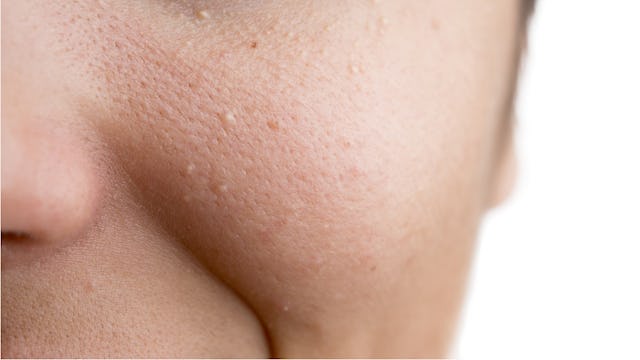Those Tiny Bumps On Your Skin Might Be Milia. Now Leave Them Alone!

Many of us have either had or seen milia. They are small, flesh-colored bumps that occur just under the skin. Often, they are mistaken for acne. But milia are actually keratin-filled cysts, a product of dead skin cells becoming trapped beneath the skin’s surface. You’ve likely seen them on a newborn (similar to baby acne) as milia are very common in infants.
I have a small cluster of milia on my chin. Since at least as early as middle school, I have had milia. I used to squeeze and pick at them, thinking I had solved the problem when a long string of gunk would emerge. Now that I have a cosmetology license and a lot more common sense, I know better.
All that picking I did could have produced a lot of scarring. I didn’t get away completely unscathed because there is some, but it could have been much worse. I thank the complexion gods on the daily for that one.
Milia will not become inflamed or infected. They are not whiteheads. They won’t turn red. In many cases, they are likely unnoticeable to anyone who isn’t inspecting your face at very close range. However, if you treat them like I did as a youth — poking them with a safety pin (that I never even bothered to sterilize) in my bathroom mirror before squeezing the gross shit out — you will be dealing with a lot of regrets. Redness, inflammation, scarring, possibly an infection (how the hell did I never contract staph?) can all occur if you attempt to extract your milia at home.
And please, please, please, do not screw around with them if they’re under your eyes. Wanna cause significant and lasting damage? Squeeze, pull, pick at, or break the delicate skin under your eyes. You will regret it. Promise.
It might be satisfying as hell to get a good pop out of one of these bumps when you’re poking and picking and squeezing. But the costs to your skin, like a loss of elasticity and a massive breakout from spreading dirt and oil through your pores, are never worth it. Do a YouTube search for pimple popping videos if it means that much to you. I promise, there’s plenty of material out there.
Take my advice and see a professional. Whether you visit a dermatologist or a licensed aesthetician, the likelihood of causing significant trauma to your skin is much lower when someone with knowledge and experience is lancing those suckers instead of you.
Prevention is key, but you still may end up with a few bumps. I’ve accepted that milia are something I am prone to, and I try to visit my aesthetician if I feel like they are getting out of control. At home, retinals, retinoids, and acid exfoliation are your best means of prevention. Because milia are caused by dead skin cells that become trapped in your pores, keeping your skin clean and exfoliated are the only means to an end of these little bumps. Though prevention techniques may not always work, there are still some things you should keep in mind. When you see milia popping up you should avoid sun exposure, don’t use oil-based creams and moisturizers, and exfoliate two to three times a week. Something to keep in mind is that milia can often be caused by chemical peels so consult with your dermatologist before you have any treatments.
And if you need to use a mechanical exfoliant like a scrub, keep it mild, and for the love of god, don’t try to power sand your face with crushed peach pits. You will only create tiny tears in your skin, which can lead to actual acne with all the redness you’re thankful your milia lack. Like with all things that commonly pop up on your face, you are way better off if you don’t freaking pop them.
Related: Good Skin Care Is NOT An Indulgent Scam — It Actually Makes A Difference
This article was originally published on